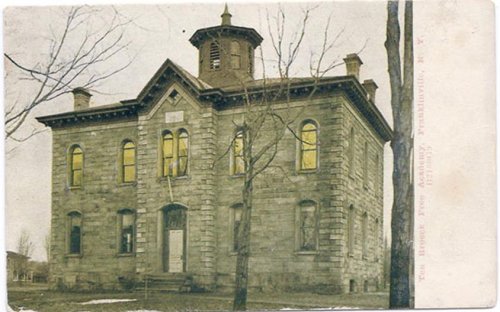Peter Ten Broeck, without an heir to his fortune, and having passed the meridian of his life, had for a long time contemplated and finally planned to bestow his wealth so that it might do the greatest good to the greatest number, and to establish imperishable honor to his name. As fast as his estate could be turned into ready means, he had decreed that the balance be expended in an endowment and construction of a literary institution known as “Ten Broeck Free Academy.” In his last will and testament, after providing certain sums of money to relatives and friends, the balance of his estate amounted to $63,000.
The construction of the building was started in 1866 and completed, including equipment, furniture and a library in 1867. It was incorporated by an Act of Legislature the same year. The cost of the building was $21,000, and was in operation in December of 1867. He also provided in his will that the privileges of this institution be free to all students residing in the three towns of Franklinville, Farmersville and Machias, as long as funds permitted. In 1878, there was permanently invested in an endowment fund, the sum of $46,000. This fund yielded an annual revenue of about $3,300.
In the early years, the school was designated by the state Education Department as a training center for teachers. In addition to this course, the classical course, which pertained to the study of the standard classics of literature and art, the music and art course and a course for the preparation of college were offered. There was also an English course, German-French course and a Latin-Greek course. Graduates from any of these courses were required to have a Regents preliminary certificate and have pursued at least three studies, exclusive of the preliminary branches each term. The first graduating class in the classical course in 1870 consisted of Alfred Spring, Joel H. Green, James H. Waring, Emily M. Adams, Ida M. Adams, Mary T. B. Button and Adam A. Gibbs.
The income from a fund of $600, given by Caleb G. Hall, annually distributed prizes to successful contestants in competitive examinations on past and current political subjects in competitive examinations on past and current political subjects. Three trustees were named in the Act of Incorporation representing the three towns respectively. The first trustees selected were Jonas K. Button, Herman G. Button and John T. Cummings. Mr. Cummings declined to serve and Andrew C. Adams was appointed in his place. He also served as vice-president of the Board. With the resignation of Jonas K. Button in 1884, Herman G. Button succeeded him and Dr. Henry VanAernam was appointed to fill the vacancy. The school had no treasurer from 1884 until at least 1893. The first principal was William M. Benson A.M. in 1882, followed by Theodore F. Chapin A.M. until his resignation in 1887. He was succeeded by Hamilton Terry A.B.
In 1904. Ten Broeck was merged with the public school and was converted into a Union Free School by the State Legislature. The high school was still called Ten Broeck. The elementary grades were taught in smaller buildings, which were added as more space was needed. In 1907 it was voted to build a new elementary school and a brick building costing $2,000 was erected on the Ten Broeck Campus and opened for use in 1909.
In 1914 as the school population increased a proposition was put up to the taxpayers to tear down the old Ten Broeck building and erect a new $16,000 school building on the site. However, with the sentiment voiced for the old building so overwhelming, it lost by a huge majority. Later the proposition passed and in 1925 the old building was torn down and a new high school was built. It is said that the light colored stone along the base of the present high school building was stone used from the original Ten Broeck building.
In the early 1950’s the school population as still increasing and it was voted to erect a new one level elementary school. Land was procured across route 16 from the high school and it was built. It opened in 1953 and was named Franklinville Central School. As the school population increased, new wings were added, providing additional classrooms. The old elementary school, attached to the high school, was torn down and a new addition replaced it. Other modifications have been made to the high school over the years, with the last being completed in 2001. Currently, in 2010 additional construction is under way at the elementary school and high school.
Peter Ten Broeck passed away on August 5, 1863. He is buried in a family cemetery, which he purchased, named Ten Broeck Cemetery on Route 16 North in the Town of Farmersville. He would be proud today of what he provided to the Towns of Franklinville, Farmersville and Machias. Upon the lid of his coffin was inscribed: “I AM ONLY REMEMBERED BY WHAT I HAVE DONE.”
Contributed by Bruce D. Fredrickson, Town of Franklinville Historian

